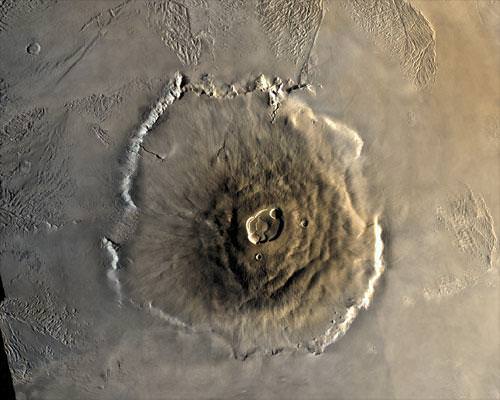[/caption]
From orbit, Olympus Mons dominates the landscape of the Tharsis region on Mars. At 24 kilometers (15 miles) high, and 550 kilometers (340 miles) in diameter, the huge volcano is over three times larger than Mount Everest. But Olympus Mons has a structure that is somewhat lopsided: it is elongated to the northwest, shortened to the southeast. A new study reveals that the ‘lopsidedness’ may mean warm magma and possibly water could be close enough to Olympus Mons’ surface to support thermophilic (heat-loving) bacteria like those found near hydrothermal vents on Earth.
While no volcanic activity has ever been seen or detected in Olympus Mons by orbiting spacecraft, the surface of the northwestern scarp has been dated from 115 million years old down to a region that is only 2 million years old. This is very recent in geological terms, suggesting that the mountain may yet have some ongoing volcanic activity.
To try and understand why Olympus Mons in lopsided, researchers Patrick J. McGovern and Julia K. Morgan from the Lunar and Planetary Institute, Universities Space Research Association, constructed detailed computer simulations of the volcano. They found the only way it could have the shape it does is if, when it was actively erupting, lava piled on top of layers of weak, water-laden clay sediments.
These layers could be hiding a trapped reservoir of water, if indeed Mars was once warmer and wetter. Whether that reservoir could still be warm, and if it could possibly hold life life remains uncertain. As of now, no orbiting satellites have any instruments that can penetrate the surface to look for a heat source.
This research was published in February 2009 in the journal Geology.


Actually, “Are organisms living inside parts of Olympus Mons?” is a good question. Since is as much about posing useful questions as getting accurate answers to them, perhaps more so. It’s one more reason to actually go to Mars and check the place out directly — we’re better than machines at making decisions about whether this area or that, this phenomenon or that is significant and worthy of extensive analysis and testing. And this is one question we really do need to find answers to, because someday we may go beyond the Solar System, and we need to know what to look for out there.
Based on the complete lack of evidence for such a unfounded claim. Well, no, not really.
So far, it appears not promising of finding anything alive/dead on this planet. The only way to find out if there is living or dead organisms is to have the next generation of Rovers drill and test in this monster volcano.
In the article, mention is made to the lack of orbiting satellites available to conduct subsurface measurements. What became of ESAs Mars Express experiment MARSIS? According to the Mars Express website, MARSIS can probe Mars’ subsurface to a depth of a few kilometers. Is this instrument nonfunctional or not of the specific type needed to conduct these subsurface measurements( MARSIS employs ground penetrating radar, not infrared capabilities)?
The article says: “As of now, no orbiting satellites have any instruments that can penetrate the surface to look for a heat source.” Please, notice: “heat source”.
Jon Hanford says: “According to the Mars Express website, MARSIS can probe Mars’ subsurface to a depth of a few kilometers.”
MARSIS is indeed able to detect _some_ structures to a depth of a few kilometers. There is no sign, that scientists are able to interpret the measurements as certain _temperatures_. But, may be, the scientists will be more imaginative in the future. It wouldn’t be for the first time 😉
Speculative science has never been precise but at last they tried to stay within there means, now I see there going beyond there own capabilities. If you don’t have the instrument or tools how can you come close to a conclusion or even a theory of something as important as a whole eco system living within a volcano on a (dead) planet. But try and try we must that is the nature of human curiosity.
Hi, every one there. I’m 24 years old and I love Mars planet and it’s latest news. Would you always send me these news. Finaly, I love you, because you love Mars planet. ;-). excuse me that I’m very weak in american language.
Salacious,
You lack any evidence that there ISN’T living organisms hiding in Olympus Mons, so your answer to the question is incorrect. The correct answer is “maybe.”
I often pose the question to myself: is there ANY part of the planet that is still sustainably warm? Considering the abundant visible features across Mars obviously created by a heat source, I would venture the answer is yes. If the answer is yes then the transitional areas surrounding this area must hold promise for living organisms.
Hi, this is a lovely article, about what are the possibilities that lies beneath the surface of mars. I agree with -Yael Dragwyla; that “we’re better than machines at making decisions about whether this area or that,” that is why I thing we should put more emphasis on building a spacecraft that can move across the solar system faster than traditional spacecrafts and less expensive also, like the Em Drive (Electromagnetic Drive) for example, I think all the major economical stabled countries of the world should come together and develop on the possibility of a converting electrical current into trust without the use of a propellant all for the Sake of the “Greater Good” rather than trying to out width each other. When we do that then each other may have one piece of the puzzel but we don’t share so we don’t know. Let’s make this of a case which can’t bother to fine out rather than we speculate be we want to know but can’t because we don’t have the technology.
The style of writing is quite familiar . Did you write guest posts for other blogs?